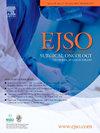胆囊癌术前诊断失败:肿瘤位置和大小对成像精度的影响
IF 3.5
2区 医学
Q2 ONCOLOGY
引用次数: 0
摘要
背景:早期胆囊癌(GBC)的术前影像学诊断仍然具有挑战性。不同的成像方式和临床因素诊断GBC的有效性尚未得到充分的研究。我们确定了GBC术前诊断失败的危险因素,包括肿瘤位置(肝脏或腹膜)和不同成像方法的大小。方法从国际多机构数据库中确定接受治疗目的GBC切除术的患者(2000-2023年)。主要结果是术前成功的GBC诊断仅基于影像学而不需要活检。多变量逻辑回归确定了与诊断失败相关的危险因素,并评估了不同成像方式的影响。结果293例患者中,术前GBC诊断成功率为164例(56.0%)。未确诊患者与确诊患者相比,肝侧肿瘤较少见(18.6%对44.5%;p = 0.033)。在多变量分析中,肝侧位置(OR:0.13 [0.02-0.76];p = 0.025,参考:腹膜侧),肿瘤大小≥2.0 cm (OR:0.11 [0.01-0.88];P = 0.035)与术前影像学诊断失败的几率较低相关。在直径2.0 cm的肿瘤中,腹膜侧病变的诊断失败风险高于肝侧病变,且风险差距随着尺寸的减小而扩大。MRI/MRCP (39.5% vs. 65.2%)和EUS (5.4% vs. 16.5%)在未确诊患者中使用的频率低于确诊患者(p <;0.001),而CT的使用相似(84.5%对85.4%;p = 0.993)。与单独使用CT相比,结合更多的成像方式,术前影像学诊断的失败率降低:仅使用CT的失败率为65.1%,而CT加MRI/MRCP或EUS的失败率为17.4%。结论腹膜侧肿瘤和病变≥2.0 cm与GBC患者术前诊断失败风险相关,特别是当使用单一成像方式时。结合不同的成像方式可以改善这类患者的术前诊断。本文章由计算机程序翻译,如有差异,请以英文原文为准。
Preoperative diagnostic failure in gallbladder cancer: Influence of tumor location and size on imaging precision
Background
Preoperative imaging diagnosis of early-stage gallbladder cancer (GBC) remains challenging. The effectiveness of different imaging modalities and clinical factors to diagnose GBC have not been fully investigated. We identified risk factors for preoperative diagnostic failure of GBC, including tumor location (hepatic vs. peritoneal) and size relative to different imaging approaches.
Methods
Patients undergoing curative-intent GBC resection (2000–2023) were identified from an international, multi-institutional database. The primary outcome was successful preoperative GBC diagnosis based solely on imaging without biopsy. Multivariable logistic regression identified risk factors associated with diagnostic failure, and the impact of different imaging modalities was assessed.
Results
Among 293 patients, preoperative GBC diagnosis was successfully made in 164 (56.0 %) patients. Hepatic-sided tumors were less common among undiagnosed versus diagnosed patients (18.6 % vs. 44.5 %; p = 0.033). On multivariable analysis, hepatic-sided location (OR:0.13 [0.02–0.76]; p = 0.025, ref:peritoneal-sided) and tumor size ≥2.0 cm (OR:0.11 [0.01–0.88]; p = 0.035) were associated with lower odds of preoperative imaging diagnostic failure. Among tumors <2.0 cm, peritoneal-sided lesions had a higher risk of diagnostic failure than hepatic-sided, with the risk gap widening as size decreased. MRI/MRCP (39.5 % vs. 65.2 %) and EUS (5.4 % vs. 16.5 %) were used less often among undiagnosed patients compared to diagnosed ones (both p < 0.001), while CT use was similar (84.5 % vs. 85.4 %; p = 0.993). The failure of preoperative imaging diagnosis decreased as more imaging modalities were combined compared with CT alone: 65.1 % for CT only versus 17.4 % for CT plus MRI/MRCP or EUS.
Conclusion
Peritoneal-sided tumors and lesions <2.0 cm were associated with higher preoperative diagnostic failure risk among patients with GBC, especially when a single imaging modality was utilized. Combining different imaging modalities may improve preoperative diagnosis among this subset of patients.
求助全文
通过发布文献求助,成功后即可免费获取论文全文。
去求助
来源期刊

Ejso
医学-外科
CiteScore
6.40
自引率
2.60%
发文量
1148
审稿时长
41 days
期刊介绍:
JSO - European Journal of Surgical Oncology ("the Journal of Cancer Surgery") is the Official Journal of the European Society of Surgical Oncology and BASO ~ the Association for Cancer Surgery.
The EJSO aims to advance surgical oncology research and practice through the publication of original research articles, review articles, editorials, debates and correspondence.
 求助内容:
求助内容: 应助结果提醒方式:
应助结果提醒方式:


